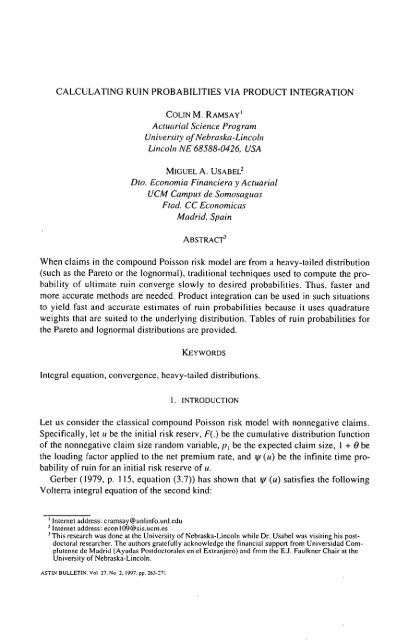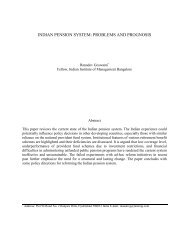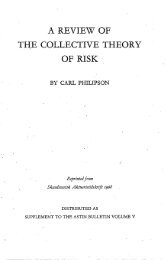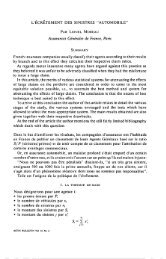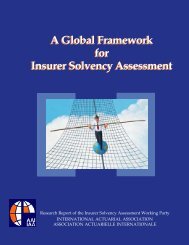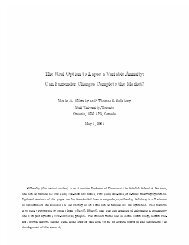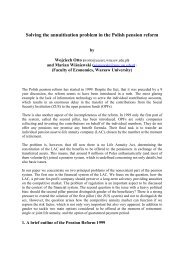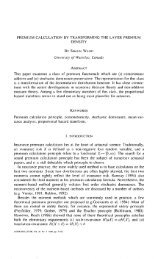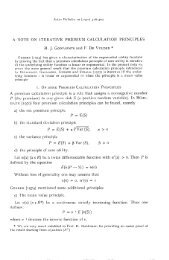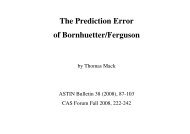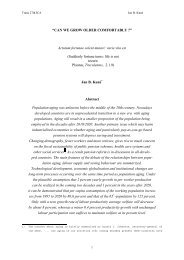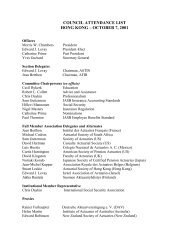CALCULATING RUIN PROBABILITIES VIA PRODUCT INTEGRATION
CALCULATING RUIN PROBABILITIES VIA PRODUCT INTEGRATION
CALCULATING RUIN PROBABILITIES VIA PRODUCT INTEGRATION
Create successful ePaper yourself
Turn your PDF publications into a flip-book with our unique Google optimized e-Paper software.
<strong>CALCULATING</strong> <strong>RUIN</strong> <strong>PROBABILITIES</strong> <strong>VIA</strong> <strong>PRODUCT</strong> <strong>INTEGRATION</strong><br />
COLIN M. RAMSAY ~<br />
Actuarial Science Program<br />
University of Nebraska-Lincoln<br />
Lincoln NE 68588-0426, USA<br />
MIGUEL A. USABEL 2<br />
Dto. Economia Financiera y Actuarial<br />
UCM Campus de Somosaguas<br />
Ftad. CC Economicas<br />
Madrid, Spain<br />
ABSTRAC'i °<br />
When claims in the compound Poisson risk model are from a heavy-tailed distribution<br />
(such as the Pareto or the Iognormal), traditional techniques used to compute the pro-<br />
bability of ultimate ruin converge slowly to desired probabilities. Thus, faster and<br />
more accurate methods are needed. Product integration can be used in such situations<br />
to yield fast and accurate estimates of ruin probabilities because it uses quadrature<br />
weights that are suited to the underlying distribution. Tables of ruin probabilities for<br />
the Pareto and Iognormal distributions are provided.<br />
KEYWORDS<br />
Integral equation, convergence, heavy-tailed distributions.<br />
I. INTRODUCTION<br />
Let us consider the classical compound Poisson risk model with nonnegative claims.<br />
Specifically, let u be the initial risk reserv, F(.) be the cumulative distribution function<br />
of the nonnegative claim size random variable, p~ be the expected claim size, I + 0 be<br />
the loading factor applied to the net premium rate, and ~ (u) be the infinite time pro-<br />
bability of ruin for an initial risk reserve of u.<br />
Gerber (1979, p. 115, equation (3.7)) has shown that ~ (u) satisfies the following<br />
Volterra integral equation of the second kind:<br />
J Internet address: cramsay@unlinfo.unl.edu<br />
2 Internet address: econ 109@sis.ucm.es<br />
This research was done at the University of Nebraska-Lincoln while Dr. Usabel was visiting his post-<br />
doctoral researcher. The authors gratefully acknowledge the financial support from Universidad Com-<br />
plutense de Madrid (Ayudas Postdoctorales en el Extranjero) and from the E.J. Faulkner Chair at the<br />
University of Nebraska-Lincoln.<br />
ASTIN BULLETIN, Vol 27, No 2, 1997, pp. 263-271
264 COLIN M. RAMSAY AND MIGUEL A. USABEL<br />
where<br />
~(u)= ---~---IA(u)+<br />
I+0L<br />
~oK(U,t)lll(t)dt ],<br />
u>_O (~)<br />
a(u) = r~| l z F( ,t, dt, u _> O (2)<br />
ou<br />
Pl<br />
I - F(u - t)<br />
K(u,t) = , O _< t
<strong>CALCULATING</strong> <strong>RUIN</strong> <strong>PROBABILITIES</strong> <strong>VIA</strong> <strong>PRODUCT</strong> <strong>INTEGRATION</strong> 265<br />
2. <strong>PRODUCT</strong> <strong>INTEGRATION</strong><br />
Consider the numerical solution of the Volterra integral equation<br />
x(s)=y(s)+ k(s,t)x(t)dt, a_
266 COLIN M. RAMSAY AND MIGUEL A USABEL<br />
It follows that<br />
where<br />
i-~ I(t,tt 7 t) _<br />
fii" =X.['" L ' ,, = p(si.,) ° . /', k(,.t,)x(,,)<br />
(t - t j)<br />
+ k(si,tj+ I )x(tj+j )<br />
hj<br />
t<br />
= ~ wo~(s ~, tj )x(tj )<br />
,=0<br />
~qp(si,t)(tl-t)dt forj = 0<br />
Wio = o h 0<br />
(tj+l<br />
Wij ff J+' P(Si, t)<br />
Ij hj<br />
= dt<br />
t)<br />
+ P(Si,t)(t-tj-I)dt for j=1,2 ..... i-I<br />
f/J j-~ h j_ I<br />
f:~ (t-ti-I)dt forj = i<br />
%2 = i-, p(s,,t) hi-I<br />
To facilitate easy computation of the weights, we introduce two new variables:<br />
As t - tj = (tj+ I - t./) - (tj+ I - t), then<br />
f/<br />
l)+l<br />
Vi) = (t j+ I - t)p(s,,t)dt<br />
2<br />
I)*l<br />
cij = [ P(si,t)dt.<br />
Wio =<br />
Vi0<br />
-<br />
ho<br />
VtJ + Cij -- -v"i-t -<br />
WO = hj h/_ I<br />
forj = 1,2,. .., i- I<br />
vi,i-I<br />
wit = ("t.l-I hi_l<br />
Thus, the approximate solution to equation (4) is determined recursively using<br />
i<br />
"~" (Si) = Y(Si ) + Z wij ~" (Si, t] )'~n (tj)<br />
j=0<br />
for i = 1,2,...,17., with<br />
The resulting estimate of x(s) is xn (s,,).<br />
.i,, (s0) = y(a).<br />
(6)<br />
(7)<br />
(8)<br />
(9)<br />
(lO)<br />
(ll)<br />
(12)
<strong>CALCULATING</strong> <strong>RUIN</strong> <strong>PROBABILITIES</strong> <strong>VIA</strong> <strong>PRODUCT</strong> <strong>INTEGRATION</strong> 267<br />
3. ACCELERATING THE CONVERGENCE<br />
We can improve the accuracy of our estimate 2,,(s)by dividing the interval [a, s] into<br />
smaller subintervals. Following the arguments of Ramsay (1992), Richardson's extra-<br />
polation technique can be used to accelerate the convergence of :~,, (s) to x(s) as n --+ ~.<br />
To this end, let us divide the interval [a, s] into n./intervals of equal length, where<br />
and 7 is a positive integer. For given j and [a, s], we have<br />
Snj = S<br />
nj=y×2 j j = 0,1,2 .... (13)<br />
h = (s - a) / nj for i = 0, 1,2 ..... Ilj -- 1<br />
S i = I i = a + ih for i = 0, 1, 2 ..... nj - 1<br />
The Richardson extrapolation technique generates a lower diagonal matrix of ap-<br />
proximations:<br />
T/:,'<br />
r/ = TrJ , + T/-I (14)<br />
2 -I<br />
for r= I, 2 ..... j andj = 1, 2 .... with To j = .~,,j (s). The final estimate of x(s) is:<br />
.~(s) = Tj. (15)<br />
4. THE MAIN RESULTS<br />
Product integration is used to compute ruin probabilities for the Pareto and Iognormal<br />
distributions. Without loss of generality, set p~ = 1 for each distribution. Tables 1 and<br />
2 show the final estimated values of the ruin probabilities after the Richardson extra-<br />
polation technique has been applied.<br />
4.1 The Pareto Distribution<br />
( ]~+'<br />
Consider the Pareto distribution defined on (0, oo) with unit mean, i.e.,<br />
Equations (2) and (3) imply<br />
F(t) = I - - o~ - o:>0andt>0.<br />
ka+t/<br />
A(u) = (~-~') a<br />
K(u't)=Iala+la+u-t<br />
Even though K(u, t) and all of its derivatives are smooth and wellbehaved, they con-<br />
verge slowly as u --~ ~. As all of the moments ,uij exist for any finite s, product inte-<br />
gration can be used.
268 COLIN M. RAMSAY AND MIGUEL A. USABEL<br />
Next set<br />
p(s,t) = K(s,t)<br />
- fl if0_
4.2 Lognormal Distibution<br />
<strong>CALCULATING</strong> <strong>RUIN</strong> <strong>PROBABILITIES</strong> <strong>VIA</strong> <strong>PRODUCT</strong> <strong>INTEGRATION</strong> 269<br />
In this case things will be more complicated because of the presence of the normal<br />
cumulative distribution function. Again we assume that<br />
p, = I. This implies<br />
A(u) = ~,?1 - F(t)dt, u _> 0<br />
ju=e -~2/2 (asp~=l)<br />
where p and (7 are the parameters of the Iognormal and<br />
u e-t 2 12<br />
A source of difficulty is in the computation of v 0 adn c 0, i.e.,<br />
f,,+, ~( In(si - t) -/../<br />
vii = ..It (tj+ l - t)(l - - ))dt<br />
j (7<br />
St j+' (1 - qb( .In(si - t) - #))dr.<br />
Cij = / (7<br />
As the function ~(.) is known only approximately, these integrals must be computed<br />
numerically; see for example Abramowitz and Stegun (1964, Chapter 26) for several<br />
approximations. The approximation used in this paper is:<br />
- ~ bkt k + e(u)<br />
• (.)=1 ~ ~,k=, /<br />
where IE(u)} < 7.5 x 10 "8, and<br />
t= l/(l+pu) p=0.2316419<br />
b~ =0.319381530 b,~ = -I.821255978<br />
b2 = -0.356563782 b5 = 1.330274429<br />
b 3 = 1.781477937<br />
Gaussian integration rules many be used to evalutate the integrals.<br />
Table 2 shows the ruin probabilities for the Iognormal distribution with (7 = 1.80<br />
and several values of 0. From equation (13), we use 7= 10 and j= 0, I, 2, 3 and 4.<br />
(Thus, n4 = 160. These values are very close to those of Thorin and Wikstad (1977),<br />
where appropriate.
270 COLIN M. RAMSAY AND MIGUEL A USABEL<br />
TABLE 2<br />
RUtN <strong>PROBABILITIES</strong>~ LOGNORMAL DISTRIBUTION (O'= 1.80)<br />
~ (u) for Various Values of u and 0<br />
u O= 0.10 O= 0.25 0 = 0.50 O= 0.75 O= 1.00<br />
10 0,739768 0,518832 0,336874 0,245749 0.192154<br />
20 0,656692 0,410781 0,240187 0,165669 0.125229<br />
30 0,593553 0.339538 0,184539 0,122940 0,091161<br />
40 0,541731 0,287396 0,147713 0,096077 0,070371<br />
50 0,497634 0,247190 0,121512 0,077676 0,056424<br />
60 0,459303 0.215164 0,101989 0,064361 0,046484<br />
70 0.425505 0.189068 0,086956 0,054343 0,039091<br />
80 0,395396 0,167437 0,075086 0,046580 0,033413<br />
90 0,368362 0,149265 0,065528 0,040423 0,028940<br />
100 0,343939 0.133830 0.057704 0,035446 0,025344<br />
200 0.188093 0,055553 0,022128 0,013482 0,009651<br />
300 0,113139 0,029147 0,011567 0.007112 0,005124<br />
400 0,072445 0,017524 0,007067 0,004390 0,003180<br />
500 0,048684 0,011534 0,004747 0,002974 0,002164<br />
600 0,034048 0.008096 0,003397 0,002143 0,001565<br />
700 0.024637 0,005960 0,002544 0,001614 0,001182<br />
800 0,018360 0,004551 0.001971 0,001257 0,000922<br />
900 0,014040 0,003577 0,001569 0,001004 0,000738<br />
1000 0,010981 0,002878 0,001276 0,000819 0,000603<br />
5. CONCLUDING COMMENTS<br />
The important strength of the product integration technique in solving equation (I) is<br />
that it converges significantly faster and is more accurate than the Goovaerts and de<br />
Vylder (1984) technique, or the improved version proposed by Ramsay (1992b). This<br />
is acheived by using a quadrature rule that exploits some of the features of the kernel,<br />
thus requiring a reduced amount of recursions. Even though the weights w 0 (and hence<br />
c,~ and %) have to be computed directly from the kernel, these extra computations are<br />
fast and easy to perform.<br />
Because product integration converges relatively rapidly, it does not require the use<br />
of small intervals, thus reducing the possibilitiy of subtracting nearly equal numbers<br />
(and hence rounding errors). In addition, it requires a small fi'action of the computa-<br />
tions required by the Goovaerts-De Vylder-Ramsay approach to obtain the same de-<br />
gree of accuracy. This should not be surprising because product integration uses much<br />
more information from the integrand than do the common Newton-Cotes quadrature<br />
formulae.<br />
A further area of research is the determination of the error bounds of the solutions<br />
generated via the product integration technique. Linz (1985, Chapter 8, p. 131) shows<br />
that the error bounds and orders of convergence for product integration follow the<br />
standard results of approximation theory. Thus, product integration based on the trape-<br />
zoidal rule is of order O(h2).<br />
Additionally, one may be able to use the Goovaerts-De Vylder-Ramsay approach<br />
and combine it with product integration to produce a faster scheme with explicit error<br />
bounds.
<strong>CALCULATING</strong> <strong>RUIN</strong> <strong>PROBABILITIES</strong> <strong>VIA</strong> <strong>PRODUCT</strong> <strong>INTEGRATION</strong> 271<br />
REFERENCES<br />
ABRAMOWrrZ, M. and STEGON, I.A. (1964). Handbook of Mathematical Functions. New York, N.Y.: Dover<br />
Publications.<br />
BOWERS, N.L., GERBER, H.U., HICKMAN, J.C., JONES, D.A. and NESBITT, C.J. (1986). Actuarial Mathematics.<br />
Ithasca, II1.: Society of Actuaries.<br />
DELVES, L.M. and MOHAMED, J.L. (1989) Computational Methods for Integral Equations. Cambridge,<br />
England: Cambridge University Press.<br />
DICKSON, D.C.M. (1989). "Recursive Calculation of the Probability and Severity of Ruin." Insurance:<br />
Mathematics and Economics, 8, pp. 145-148.<br />
DJCKSON, D.C.M., EGIDZO DOS REIS, A.D. and WATERS, H.R. (1995). "Some Stable Algorithms in Ruin<br />
Theory and Their Application." Astin Bulletin 25, pp. 153-175.<br />
DICKSON, D.C.M. and WATERS, H.R. (1991) "Recursive Calculation of Survival Probabilities." Astin Bulle-<br />
tin 21, pp. 199-221.<br />
GERBER, H.U. (1979) An Introduction to Mathematical Risk Theoo,. Huebner Foundation Monograph 8.<br />
Philadelphia, Pa.: University of Pennsylvania. (Distributed by Irwin, Homewood, IL.)<br />
GOOVAERTS, M. and DE VYLDER, F. (1984) "A Stable Recursive Algorithm for Evaluation of Ultimate Ruin<br />
Probabilities." Astin Bulletin, 14, pp. 53-59.<br />
GRaNDELL,J. (I 990). Aapects of Risk Theory. Springer Verlag, New York.<br />
LINZ, P. (1985). Analytical and Numerical Methods for Volterra Equations. Philadelphia, Pa.: SIAM Studies<br />
in Applied Mathematics.<br />
PANJER, H.H. (1986) "Direct Calculation of Ruin Probabilities.'" Journal of Risk and Insurance, 53, pp. 521-<br />
529.<br />
PANJER, H.H. and WANG, S (1993) "On the Stability of Recursive Formulas."ASTIN Bulletin, 23, pp. 227-<br />
258.<br />
RaMSaY, C.M. (1992a) "A Practical Algorithm for Approximating the Probability of Ruin.'" Transactions of<br />
the Society of Actuaries, XLIV, 443-459.<br />
RAMSAY, C.M. (1992b) "Improving Goovaerts' and de Vylder's Stable Recursive Algorithm." Astin Bulle-<br />
tin, 22, pp. 51-59.<br />
THORIN, O. and WIKSTAD, N. (1977) "Calculation of Ruin Probabilities When the Claim Distribution is<br />
Lognormal.'" Astin Bullethl, 9, pp. 231-246.<br />
YOUNG, A. (1954) "Approximate Product Integration." Proc. Royal Soc. London, Ser. A, 224. pp. 561-573.


